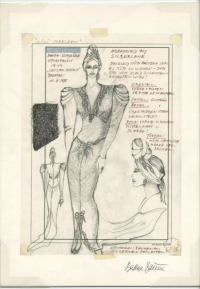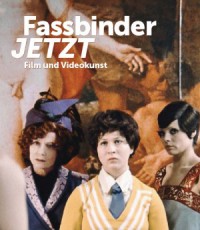The Catalogue
Fassbinder – NOW. Film and Video art
In March 1982, three months before his death, Rainer Werner Fassbinder explained: „I don’t believe in video […] I don’t believe you can replace film with video technology.“ The video artists of the time, conversely, didn’t believe in the cinema, writes Anna Fricke, curator of the exhibition Fassbinder – NOW (6th May 2015 til 23rd August 2015) at the Martin-Gropius-Bau, in her contribution to the catalogue being published in conjunction with the exhibition. Thus, Wolf Vostell and Nam June Paik concentrated at first on television in their artistic-critical investigations. Cinematic references? Negative! That did not undergo a fundamental change till the 90s, Fricke continues, when visual artists began, almost abruptly, to interest themselves in cinema.
Film and Video art is the subheading of the exhibition Fassbinder – NOW, which examines the way in which contemporary video artists reference Fassbinder’s themes and aesthetic strategies today, thus linking him to the present. In her introductory words, Fricke sets out the exhibition’s thematic framework while summing up the ways in which video and other visual artists have been dealing with Fassbinder, from the 90s up to the present day, from Monica Bonvicini through Rirkrit Tiravanija and Brice Dellsperger to Ming Wong.
 How the cinema and the film aesthetic have gradually found their way into art museums is analysed in-depth, using many examples, by Ursula Frohne in her article „Expanded Fassbinder – On the Aesthetic Legacy of Cinema In Contemporary Art“. Cinema lovers in the age of the ever-present digital image may take heart from her finding, with reference to Jacques Rancière, that “paradoxically, it is in its ,new hybrid forms’, which extend it into the museum, that cinema is succeeding in regenerating itself and having an impact beyond itself“.
How the cinema and the film aesthetic have gradually found their way into art museums is analysed in-depth, using many examples, by Ursula Frohne in her article „Expanded Fassbinder – On the Aesthetic Legacy of Cinema In Contemporary Art“. Cinema lovers in the age of the ever-present digital image may take heart from her finding, with reference to Jacques Rancière, that “paradoxically, it is in its ,new hybrid forms’, which extend it into the museum, that cinema is succeeding in regenerating itself and having an impact beyond itself“.
The catalogue, more than 300 pages long, offers the opportunity to come to grips with all of the exhibition’s thematic concerns: in several compilations of excerpts from Fassbinder’s films, the topics that occupied him are illustrated, as is his formidable repertoire of aesthetic techniques. These are juxtaposed with the works of six contemporary video artists. Furthermore, the items on display, made available by the Rainer Werner Fassbinder Foundation Berlin, the exhibition’s cooperating partner – screenplays, documents, correspondence, notes, photographs – provide the visitor with insight into Fassbinder’s methods of thinking and working.
These broad thematic arcs in the exhibition are reproduced and amplified in the catalogue: authors such as Brigitte Peucker, Cristina Nord and Thomas Elsaesser make contributions dealing first and foremost with analyses of the works: “Fassbinder Re-framed“ (Peucker), “,The little bit of freedom’ – Rainer Werner Fassbinder and Television“ (Nord) and “Retroactive Prescience: Fassbinder’s THE THIRD GENERATION“ (Elsaesser).
“Forms of exclusion, oppression, exploitation and (self-)destruction – sometimes more subtly, sometimes more overtly. As Fassbinder saw it, violence and power belong to the basic features of the present“, writes Nisaar Ulama in his text “Stories of Violence: How Tom Geens and Rainer Werner Fassbinder tell of a Possible Present and a Concrete Past“. This article examines, from the perspective of Fassbinder’s work, how it is linked to the society of fear and repression depicted in Tom Geens’ short film YOU’RE THE STRANGER HERE.
Four of the six artists represented in the exhibition illuminate their own personal relationships to Fassbinder and his body of work in short essays: Tom Geens, Maryam Jafri, Jesper Just and Ming Wong. Also present in the exhibition are Runa Islam and Jeroen de Rijke / Willem de Rooij. Ralf Michael Fischer, Bridget Crone, Lilian Haberer and Svetlana Svyatskaya, herself the assistant curator for the whole exhibition, join Anna Fricke in subjecting the video artists’ works to incisive analysis.
Hans-Peter Reichmann, the head of the Deutsches Filmmuseum’s archives, concludes the catalogue with a mention of the treasures to be found among the thousands of documents safeguarded by the Rainer Werner Fassbinder Archive, including, for example, the visibly well-worn working script for LILI MARLEEN (1980), containing many hand-written notes and comments by the prominent post-war German director.
The catalogue is published in both German and English editions, and it is rounded off by a Fassbinder filmography. An illustrations section more than 100 pages long enables immersion in the works of the participating artists. Comparison of aesthetic processes at the level of the individual frame makes it possible to see the way visual language is used to reference Fassbinder in the works of the video artists.
 FILMSTOFFE –
Kostüme Barbara Baum
FILMSTOFFE –
Kostüme Barbara Baum
„I always think in fabrics.“ Barbara Baum
Her zest for life is her trademark. Three of the prominent authors who contributed a text to the current book about the costume designer Barbara Baum mention her laughter, which reliably rang out during shooting. “And if you could not make her out right away in a forest of clothes, all you had to do was follow her laughter, which bubbled out of her as easily as champagne out of an uncorked bottle,” writes Hanna Schygulla. And most of the authors also place emphasis on Barbara Baum’s striking professionalism, her meticulous research, her relentless passion for detail: Juliane Maria Lorenz recalls how the costume designer stepped in front of the camera on the first day of shooting Rainer Werner Fassbinder’s FONTANE EFFI BRIEST (Germany 1972–74) and “in a very friendly way pointed out that shooting could not begin yet, because the original enamel brooch was missing from Ms. Schygulla’s neck.” Fassbinder did not know if he should be infuriated or not, recalls Lorenz, his longtime companion and the editor of many of his films, but then “this scene was apparently a revelation for him: because for all intents and purposes, his costume designer had conveyed to him what it means to really take one’s job seriously.”
In short contributions, numerous of Fassbinder’s companions along the way—from Michael Ballhaus and Iris Berben to Volker Schlöndorff and Detlev Buck—recall joint film projects and point out, such as, for instance, the director Heinrich Breloer (BUDDENBROOKS, Germany 2008), that Baum’s clothes “not only bring the period immediately mind, but at the same time say something about people’s emotional lives.” Or they express their gratitude, such as Armin Mueller-Stahl, who reports how he did not realize what kind of person he was until the instant he slipped into the suit of his character in Fassbinder’s LOLA: “I knew how I was supposed to play von Bohm. … She is, and remains, the best I have ever worked with!”
If one is familiar with Barbara Baum’s credo, as she formulates it in an interview with Hans-Peter Reichmann and Ann-Christin Eikenbusch, then this admiration does not come as a surprise: “If a costume is historically accurate but the actor is unhappy with it, then it’s wrong and has to be rethought. The costume always has to support the role — it doesn’t work the other way around.”
The book is sponsored by Adolf- und Luisa Haeuser-Stiftung.
In collaboration with: Rainer Werner Fassbinder Foundation & Capital Cultural Fund in Berlin
Catalogue:
Fassbinder – NOW. Film and video art
Published by: the Deutsches Filminstitut, Frankfurt am Main and the Rainer Werner Fassbinder Foundation, Berlin
Catalogue design: Sabine Pflitsch and Andreas Tetzlaff (probsteibooks, Cologne)
Retail price: 25 €
FILMSTOFFE – Kostüme Barbara Baum
Published by: Deutsches Filminstitut, Frankfurt am Main and the Rainer Werner Fassbinder Foundation, Berlin
Language: German
Retail price: 19,80 €
